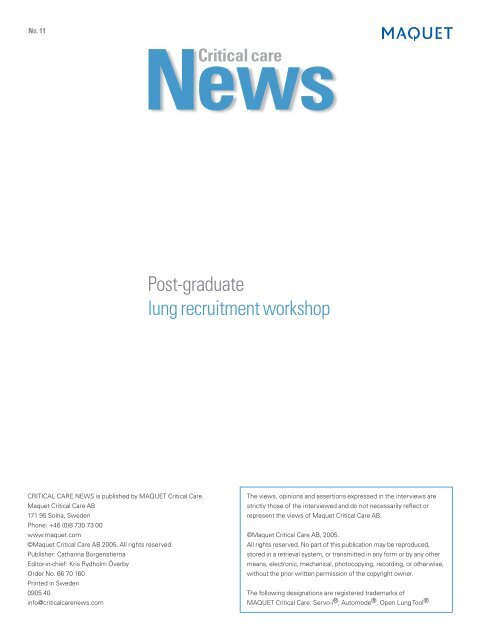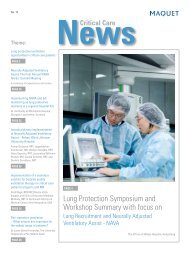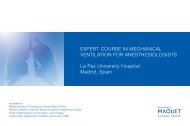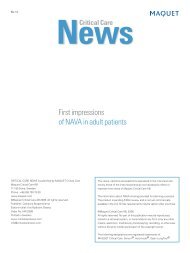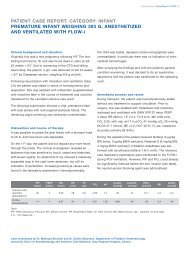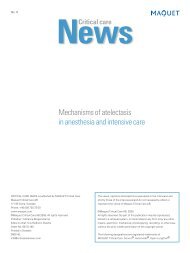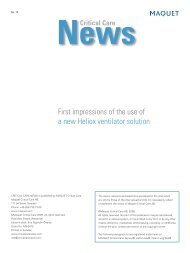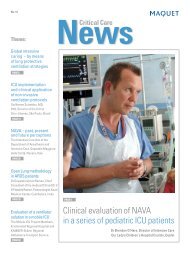READ - Critical Care News
READ - Critical Care News
READ - Critical Care News
Create successful ePaper yourself
Turn your PDF publications into a flip-book with our unique Google optimized e-Paper software.
NO. 11<br />
<strong>News</strong><br />
<strong>Critical</strong> care<br />
Post-graduate<br />
lung recruitment workshop<br />
CRITICAL CARE NEWS is published by MAQUET <strong>Critical</strong> <strong>Care</strong>.<br />
Maquet <strong>Critical</strong> <strong>Care</strong> AB<br />
171 95 Solna, Sweden<br />
Phone: +46 (0)8 730 73 00<br />
www.maquet.com<br />
©Maquet <strong>Critical</strong> <strong>Care</strong> AB 2005. All rights reserved.<br />
Publisher: Catharina Borgenstierna<br />
Editor-in-chief: Kris Rydholm Överby<br />
Order No. 66 70 160<br />
Printed in Sweden<br />
0905 40.<br />
info@criticalcarenews.com<br />
The views, opinions and assertions expressed in the interviews are<br />
strictly those of the interviewed and do not necessarily reflect or<br />
represent the views of Maquet <strong>Critical</strong> <strong>Care</strong> AB.<br />
©Maquet <strong>Critical</strong> <strong>Care</strong> AB, 2005.<br />
All rights reserved. No part of this publication may be reproduced,<br />
stored in a retrieval system, or transmitted in any form or by any other<br />
means, electronic, mechanical, photocopying, recording, or otherwise,<br />
without the prior written permission of the copyright owner.<br />
The following designations are registered trademarks of<br />
MAQUET <strong>Critical</strong> <strong>Care</strong>: Servo-i ® , Automode ® , Open Lung Tool ®
<strong>Critical</strong> <strong>Care</strong> <strong>News</strong> | 19<br />
Post-graduate workshop in lung recruitment:<br />
concept, principles and practical clinical application<br />
Professor Hedenstierna with workshop physicians<br />
After the fundamental lecture in the mechanisms<br />
of atelectasis, workshop participants<br />
were given an overview of the inherent risks<br />
of ventilator-induced lung injury (VILI) in older<br />
methods of mechanical ventilation with high<br />
tidal volumes and low PEEP, such as initiation<br />
or maintenance of an inflammatory response,<br />
causing or accelerating lung injury. The<br />
limitations of applying pressure-volume loops<br />
in clinical practice were also discussed.<br />
The concept and method of delivery for lungprotective<br />
ventilation management, guided by<br />
the physiological response of the patient, was<br />
also reviewed in the workshop. The recommendations<br />
for practice, ventilatory objectives and<br />
sequence of management decision-making as<br />
published by Marini and Gattinoni were<br />
included, as well as other publications and<br />
recruitment material tools.<br />
The following aspects of interventional<br />
assessment were highlighted in the workshop:<br />
Guidance and standardization for a<br />
prescribed recruitment maneuver<br />
Identification of collapse point –<br />
PEEP titration<br />
Monitoring of breath-by-breath vital<br />
parameters for evaluation of the patient<br />
response to intervention<br />
Identification of patients unlikely to benefit<br />
from a recruitment maneuver<br />
Assessment of the patient response to<br />
intervention, by means of dynamic compliance<br />
and carbon dioxide excretion trends<br />
Over a two-day period in the physiological<br />
laboratory, each workshop participant was<br />
given several opportunities to apply the course<br />
recruitment maneuver in clinical practice.<br />
Lung recruitment maneuver<br />
1) Assessment of baseline clinical situation.<br />
2) Application of increased end inspiratory<br />
pressure (EIP), with corresponding increase in<br />
VTCO 2 (tidal elimination) as activated alveoli<br />
participate in gas exchange.<br />
3) Monitoring of the plateau state of VTCO 2 ,<br />
when no additional alveoli may be recruited.<br />
4) A slow step-by-step decrease in PEEP to<br />
identify the maximum value of dynamic<br />
compliance (Cdyn i) as indication of lung<br />
compartments closing again. Collapse<br />
pressure was identified as the corresponding<br />
plateau/max value of Cdyn i and VTCO 2 .<br />
5) The lung was re-recruited at the previously<br />
used opening pressure.<br />
6) PEEP was established at 2 cm H 2 0 above<br />
collapse pressure, and ventilation was<br />
maintained at this level.
20 | <strong>Critical</strong> <strong>Care</strong> <strong>News</strong><br />
The post-graduate lung recruitment course held in April at the Academic Hospital in Uppsala, Sweden<br />
attracted many international participants, with attending physicians from Scandinavia, Central Europe,<br />
Russia and Singapore. <strong>Critical</strong> <strong>Care</strong> <strong>News</strong> asked some of the participants about feedback after attending<br />
the educational and lab sessions.<br />
Dr Csaba Micskei, anesthesiology and<br />
intensive care, Hungary<br />
Dr Luis Telo, pneumologist and intensive<br />
care physician, Portugal<br />
Why did you choose to attend this course?<br />
What was your goal in attending the course?<br />
My boss, Professor Béla Fülesdi, urged me to<br />
attend because we hope to offer a ventilatory<br />
course for colleagues in Hungary. We offer a<br />
resuscitation course, and we want to offer a<br />
ventilatory support course for post-graduate<br />
training at our hospital.<br />
I don’t do recruitment maneuvers, but I am<br />
interested in the concept, and I wanted to learn<br />
how to do it.<br />
What is the most valuable thing you have<br />
learned from the course?<br />
What is the most valuable thing you have<br />
learned from this course?<br />
To use this physiological method and tool and<br />
become familiar with it, in order to see the<br />
ventilation curves and physiology from another<br />
perspective. After this course, I hope to use<br />
the recruitment maneuver; this course is a<br />
good practice run, giving physiological training<br />
before treating the patients.<br />
To understand the mechanics of the lung,<br />
and the physiological process of opening<br />
the alveoli and keeping them open.<br />
Will you try working with recruitment<br />
maneuvers when you return to Portugal?<br />
Yes, I think so. We have two intensive care<br />
units at my hospital, with about five beds each.<br />
So we are a small group at my hospital and I<br />
Dr Luis Telo, pneumologist and<br />
intensive care physician, Portugal<br />
Dr Csaba Micskei, anesthesiology and<br />
intensive care, Hungary
<strong>Critical</strong> <strong>Care</strong> <strong>News</strong> | 21<br />
We recently purchased eight SERVO-i<br />
ventilators, and I learned about this course<br />
from our local MAQUET representative. I was<br />
interested in the lung recruitment procedure,<br />
and I thought this would be a useful way to<br />
learn about the concept, and become familiar<br />
with the mechanism of using it.<br />
What course experiences have been most<br />
beneficial to you?<br />
The hands-on experience with the recruitment<br />
procedure, before I start using it on my patients.<br />
But it was also beneficial to share experiences<br />
with the international delegates; it is interesting<br />
to meet fellow physicians from other parts of<br />
Europe and the world.<br />
So you intend to use this methodology and<br />
tool on patients?<br />
Dr Beata Oscarsson and Dr Ingemar Lindström, Sweden, anesthesiologists and intensive<br />
care physicians<br />
think some of my colleagues will be interested procedure and the clinical principles involved,<br />
in learning about lung recruitment as well. it is very easy. However, it needs reflection and<br />
practice. But we are eager to use this concept,<br />
routine and tool on patients as soon as we get<br />
Dr Beata Oscarsson and Dr Ingemar<br />
back home.<br />
Lindström, Sweden, anesthesiologists<br />
We suspect that in patients with different<br />
and intensive care physicians<br />
disease processes, there may be some<br />
challenges when applying this method. But<br />
What were your expectations of this course? that is why it is so valuable to learn the<br />
fundamentals in this setting.<br />
We expected to learn how to use these<br />
We have a trend to have our patients less<br />
procedures and instruments when working sedated on the ventilator, so this could be<br />
with severely ill patients.<br />
valuable to use on the sickest patients, in order<br />
We are impressed by the international scope to achieve spontaneous breathing more quickly.<br />
of this training. It has been a benefit to meet<br />
doctors from many other countries.<br />
Dr John Gannon, United Kingdom<br />
What was the most beneficial aspect of<br />
the training?<br />
Can you tell us about you background and<br />
why you are attending this course?<br />
The fact that we could learn how to use the<br />
method and tool for clinical support in a<br />
I am an anesthesiologist, with an interest in<br />
physiological environment in the labs. It would intensive care. That’s the way most of the units<br />
have been difficult to learn about these recruitment<br />
maneuvers from books or manuals only. run by anesthesiologists with an interest in<br />
in the United Kingdom are managed; they are<br />
critical care medicine. Our critical care<br />
Did you find the concept and procedure environment is comprised of a high-dependency<br />
easy or difficult?<br />
area and a critical care area. We have a total of<br />
16 beds, broken down roughly to nine level<br />
Once you have learned the basics, and can set three beds, and seven high dependency beds,<br />
reasonable expectations about how to run the but the match depends on what the needs are.<br />
Yes, and hopefully I will be able to disseminate<br />
the knowledge back to my colleagues when I<br />
return home.<br />
It has been valuable to train these recruitment<br />
maneuvers in a physiological lab environment,<br />
since you have a hesitancy to apply new<br />
methodologies directly on your patients for the<br />
first time. This also gave us the ability to try out<br />
some theories that perhaps otherwise we<br />
would not get the opportunity to do.<br />
Dr John Gannon, United Kingdom


